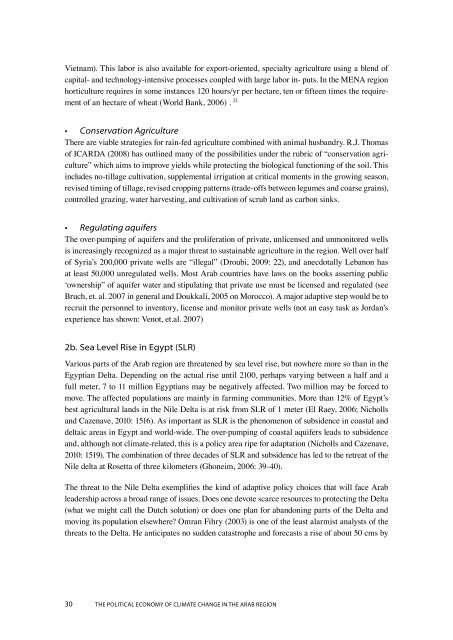The Political Economy of Climate Change in Arab Countries
The Political Economy of Climate Change in Arab Countries
The Political Economy of Climate Change in Arab Countries
You also want an ePaper? Increase the reach of your titles
YUMPU automatically turns print PDFs into web optimized ePapers that Google loves.
Vietnam). This labor is also available for export-oriented, specialty agriculture us<strong>in</strong>g a blend <strong>of</strong>capital- and technology-<strong>in</strong>tensive processes coupled with large labor <strong>in</strong>- puts. In the MENA regionhorticulture requires <strong>in</strong> some <strong>in</strong>stances 120 hours/yr per hectare, ten or fifteen times the requirement<strong>of</strong> an hectare <strong>of</strong> wheat (World Bank, 2006) . 21• Conservation Agriculture<strong>The</strong>re are viable strategies for ra<strong>in</strong>-fed agriculture comb<strong>in</strong>ed with animal husbandry. R.J. Thomas<strong>of</strong> ICARDA (2008) has outl<strong>in</strong>ed many <strong>of</strong> the possibilities under the rubric <strong>of</strong> “conservation agriculture”which aims to improve yields while protect<strong>in</strong>g the biological function<strong>in</strong>g <strong>of</strong> the soil. This<strong>in</strong>cludes no-tillage cultivation, supplemental irrigation at critical moments <strong>in</strong> the grow<strong>in</strong>g season,revised tim<strong>in</strong>g <strong>of</strong> tillage, revised cropp<strong>in</strong>g patterns (trade-<strong>of</strong>fs between legumes and coarse gra<strong>in</strong>s),controlled graz<strong>in</strong>g, water harvest<strong>in</strong>g, and cultivation <strong>of</strong> scrub land as carbon s<strong>in</strong>ks.• Regulat<strong>in</strong>g aquifers<strong>The</strong> over-pump<strong>in</strong>g <strong>of</strong> aquifers and the proliferation <strong>of</strong> private, unlicensed and unmonitored wellsis <strong>in</strong>creas<strong>in</strong>gly recognized as a major threat to susta<strong>in</strong>able agriculture <strong>in</strong> the region. Well over half<strong>of</strong> Syria’s 200,000 private wells are “illegal” (Droubi, 2009: 22), and anecdotally Lebanon hasat least 50,000 unregulated wells. Most <strong>Arab</strong> countries have laws on the books assert<strong>in</strong>g public‘ownership” <strong>of</strong> aquifer water and stipulat<strong>in</strong>g that private use must be licensed and regulated (seeBruch, et. al. 2007 <strong>in</strong> general and Doukkali, 2005 on Morocco). A major adaptive step would be torecruit the personnel to <strong>in</strong>ventory, license and monitor private wells (not an easy task as Jordan’sexperience has shown: Venot, et.al. 2007)2b. Sea Level Rise <strong>in</strong> Egypt (SLR)Various parts <strong>of</strong> the <strong>Arab</strong> region are threatened by sea level rise, but nowhere more so than <strong>in</strong> theEgyptian Delta. Depend<strong>in</strong>g on the actual rise until 2100, perhaps vary<strong>in</strong>g between a half and afull meter, 7 to 11 million Egyptians may be negatively affected. Two million may be forced tomove. <strong>The</strong> affected populations are ma<strong>in</strong>ly <strong>in</strong> farm<strong>in</strong>g communities. More than 12% <strong>of</strong> Egypt’sbest agricultural lands <strong>in</strong> the Nile Delta is at risk from SLR <strong>of</strong> 1 meter (El Raey, 2006; Nichollsand Cazenave, 2010: 1516). As important as SLR is the phenomenon <strong>of</strong> subsidence <strong>in</strong> coastal anddeltaic areas <strong>in</strong> Egypt and world-wide. <strong>The</strong> over-pump<strong>in</strong>g <strong>of</strong> coastal aquifers leads to subsidenceand, although not climate-related, this is a policy area ripe for adaptation (Nicholls and Cazenave,2010: 1519). <strong>The</strong> comb<strong>in</strong>ation <strong>of</strong> three decades <strong>of</strong> SLR and subsidence has led to the retreat <strong>of</strong> theNile delta at Rosetta <strong>of</strong> three kilometers (Ghoneim, 2006: 39-40).<strong>The</strong> threat to the Nile Delta exemplifies the k<strong>in</strong>d <strong>of</strong> adaptive policy choices that will face <strong>Arab</strong>leadership across a broad range <strong>of</strong> issues. Does one devote scarce resources to protect<strong>in</strong>g the Delta(what we might call the Dutch solution) or does one plan for abandon<strong>in</strong>g parts <strong>of</strong> the Delta andmov<strong>in</strong>g its population elsewhere? Omran Fihry (2003) is one <strong>of</strong> the least alarmist analysts <strong>of</strong> thethreats to the Delta. He anticipates no sudden catastrophe and forecasts a rise <strong>of</strong> about 50 cms by30 THE POLITICAL ECONOMY OF CLIMATE CHANGE IN THE ARAB REGION
















